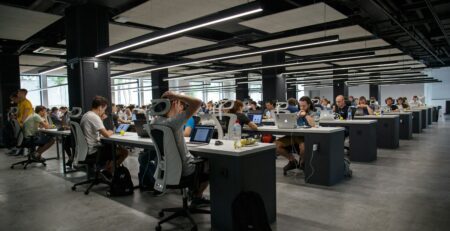Navigating the Return to Work
Unprecedented changes in the last two years completely changed the way we look at work and work arrangements. At some points, this happened with little or no warning. The push toward remote work has been one of the most pressing initiatives for businesses in every industry and creatives were at the forefront.
Since most of the tools creatives use are already based in software and can be done off-site, they were some of the first to leave traditional offices and will probably be some of the last to go back. But we can’t blame this trend entirely on the events of late 2019. Remote work was already a growing popular trend in the mid-naughts.
There’s no doubt that the same problems still rage on in many parts of the world. This article is not to pretend that everything has gone back to normal, but rather a careful examination of the multitude of considerations and possible problems that businesses are likely to have as people continue returning to in-person jobs.
Employee Safety Is Key
Before we get into the small details, it’s important to layout from the start that the number one consideration for any business looking to move its people back into office spaces is to prevent people from getting ill and suffering long-term consequences. The bottom line is an inherent part of the business world, but in this case, it’s not the main priority.
Fortunately, many of the remote work arrangements created in response to social distancing directives were as lucrative or even more so than the original in-person way.
Will People Ever Return From Remote Work?
This is a difficult question to answer with any certainty, especially for creatives. Since they are particularly adept at working on a computer from pretty much anywhere, creatives are almost destined to be fully remote workers. If that means WFM, so be it.
In many cases, creatives never had their own departments in brick-and-mortar offices. Big companies may have made space for them if they were constantly in use. Small boutiques would typically have office spaces where their employees could work as outsourced design arms for other companies of almost any size.
The final consideration to make is whether the work from home arrangement is working at a given company. It can save money on rent and utilities for the company and most people are happier working at home than not. For many white-collar workers, remote work has even been shown to have increased productivity.
In brief, it appears that a significant number of people will remain WFH or in fully remote work positions for a long time to come. That may not be the case for jobs where face-to-face interaction is required, though.

What Companies Need For the Return to Work
If you are in a position where you need all or some employees to return to a traditional office, there are some things you have to do to make sure they return confident that they are safe.
Try this short list of suggestions to make sure your company has everything in place whenever it is ready to bring staff back into the workplace.
- Approval
Naturally, the same regulators enforcing social distancing and other measures will be the same ones to send the all-clear when it’s safe for people to get back to the office. Look out for medical professionals and health organizations to explain what we can expect and also for breakthrough information about possible health hazards that might slow things down.
You’ll also need your employees’ approval. There are two reasons you should send out surveys to find out how many of your employees are ready and willing to return safely to the old way of working. Firstly, if they all prefer remote work and it will save you money, then that would be the smart thing to do.
Secondly, your staff is the backbone of your company. They’re already trained and working the jobs you need them to do. Rushing a return to work will cost you a ton in retraining and onboarding expenses.
- A Plan
What will the return to work look like? In some sense, it’s up to individual companies. Will the office just be open one day, free for people to come back and pretend nothing happened? Will new restrictions or a more sparse floor plan be in place?
You need to start with a notice from HR to your employees that reopening will occur, preferably with plenty of advance notice. If you took surveys to gauge reactions from the entire staff, then show them that information so they know it isn’t just a push from management for everyone to get back into the office.
Before the announcement is sent, you should have an exact knowledge of what the newly reopened office will look like. This isn’t a plan based on theory, either. Involve the decision-makers at the business when you develop a plan for what’s possible and what kind of timeline it can reasonably occur on.
- Precautions for Employee Safety
Depending on what the guidelines for companies are in your locality, you might not be returning to the traditional workplace exactly as you left it. In some places, social distancing and masking measures are still to be enforced within offices.
These kinds of restrictions are clearly important to follow, but there are also some other rules that would apply in the event someone was sick. In essence, your company should be crystallizing the lessons learned from 2019 onward into policy and solutions. For example, a relief day or sick day policy should cover all employees and be easy to access.
This is not only in the interest of fairness but also in the interest of good business. We know that a few cases of disease can spread quickly – imagine people who have no other option than staying at work or returning to work early because they fear for their jobs. Your traditional office reopens and then closes again, tarnishing any trust from the employees that it could ever realistically reopen safely.
- Updated Tech
Lots of very clever solutions came out of the sudden requirements in early 2020. One great example is touchless technology. Most companies have been using scan cards to open doors or soap dispensers with motion sensors since the 90s or early 2000s. But touchless technology can do even more.
Some companies offer time clocks that use facial recognition to log employees in, let them clock out, and take a lunch break. In the traditional workplace, a standard time clock would have been touched by everyone on a shift that day.
Just be wary of privacy concerns when it comes to this technology. Employee safety and their right to privacy don’t always have to be at odds. Be transparent about what data your company is gathering from employees to power these touchless time clocks, where it is stored, and how it is destroyed when it is no longer needed.
- Metrics
Just like you would on any project, you need to be able to measure how effective returning to work has been. That doesn’t only mean financials. Aggregated and regularly updated figures might show many employees are comfortable with the return to the traditional workplace, who has reported illnesses, and who can and cannot report to the office at a given time.
Contact tracing is another way you could implement these figures to your benefit. If someone does get sick, you can quickly and effectively warn anyone who had recent close contact with that person. Make sure you respect privacy with this contact tracing initiative as well. For example, you might want the message to say “someone” is sick rather than naming a specific name.
The only way to know if something is working or not is to look for results that can tell you. Metrics don’t have to be secretive and invasive, either. They can be based on employee reporting and still do a good job keeping employees safe while also keeping the office culture agreeable for everyone.
Creatives Returning to Work
Remote work is one of the most heavily favored employee benefits for creatives. For most, meetings can be scheduled so that all the creative work is done at a certain time of day without any interruptions. Many creatives have found this to be extremely helpful at boosting productivity rates because their natural creative times can be exploited better.
A central concern for many creatives as this remote work may disappear is that they no longer see much point coming to the office. Most of the time, management agrees and finds remote work much more convenient from their side as well. But sometimes management wants to be able to have more oversight of the staff and therefore wants to bring them back into a more traditional workplace set up.
Beyond the remote work problem, many creatives were forced to begin freelancing because the more permanent jobs no longer existed. Would returning to work at a more traditional workplace be beneficial in any meaningful way?
It depends on the individual. Some people found that they enjoyed the higher risk and freedom of freelancing while others would prefer to have the employee benefits and clear career path that a traditional job can provide. In the best-case scenario, creatives who would like to return to the workplace on a more permanent basis have managed to find some freelance work to continue building their skills and have some projects in their portfolio to cover for the freelancing period.
Make Sure the Details Are Covered
Although it’s not the most entertaining topic of discussion, decision-makers and managers should take care to make sure every aspect of returning to work has been covered explicitly and delivered to current and new employees.
Employees returning to work have to make sure that their employers have sent them this kind of information. It’s never too late to implement a new policy, but once people get back into the traditional workplace it might be too late.
Various examples of varying levels of consequences. For example, the company needs to clarify how much and what kind of company-owned equipment will be distributed across hybrid teams of both remote and traditional employees. If they fail to do so, it might be a wrench in the gear of whichever teams are affected.
But the stakes are higher than that for some other choices. Healthcare coverage and sick day policy might make all the difference in the world for employees who get sick.
Do employees have a choice about returning to work? Should they be looking for childcare options? Can they work a few days a week from home? There need to be clear answers to all these questions before the return to work can begin.
From a business standpoint, you also need to make sure all your systems can handle another shift. Tons of IT professionals were working overtime when the social distancing orders came, trying to make sure workforce tech and companies more generally could work successfully and protect essential data when almost everyone on the team was forced to go remote.
Can your company’s IT support a hybrid workforce where people may be using a blend of personal and company-owned devices? If you aren’t sure, don’t take that risk. Not only could business grind to a halt, but you could potentially be opening yourself up to legal action by risking personal data to a breach.
Be Clear About The Return to Work
Regulations and medical advice have been changing rapidly for over a year now and it can be hard to keep up. But that’s no reason for companies to enter into the fray and confuse things even further. If you don’t know what the final word will be from regulators and you find that your communication RE reopening is only confusing employees, then you should keep things more or less the way they are now.
Set definite goals and work with employees to survey what everyone wants, see what is possible, and set a path forward. The best way is most likely to be a heavily researched action plan with an extended gradual rollout so that there is plenty of time to see what is working and what’s not and stop everything before it can cause lasting damage.
However, this is going to take lots of technical know-how and a commitment to patience. Teams and leaders should be empowered at every level to ensure this is done effectively and safely so that it can last into the long term.
When Is the Return to Work?
For many people across the world, the return to work is either an impossibly long distance in the future or it doesn’t need to occur because they were either fired or never had the opportunity to stop working. If you are living in a place where there are whispers or even full-on plans for returning to work, then there’s still no telling when exactly it could be.
People have had a long, hard couple of years. For all the strategizing and planning about trying to get back to normal, we can’t forget that empathy is the first step toward the best answer. Rushing doesn’t do anyone any good. The worst-case scenario delays a proper return by a long time. Best-case scenario people will be able to go back to the office but may not be as confident about management’s concern for employee safety.
The most important consideration about the return to work is that it spans industries and even communities. It is a societal issue that each company and every employee has to construct and carry out for themselves as safely as possible. If you aren’t completely sure about the aspects of it discussed in this guide, it’s better to wait and get your answers before trying to return to the traditional workplace.

Conclusion:
Employee safety should be the number one consideration when you’re planning for the return to work. It’s going to be a long and complicated process, if only because it’s so critical to be careful about it and make sure it is done correctly so we don’t have to worry about having to do it again in the future.
Companies should rely on their employees to decide whether remote workers should be brought back in and whether the IT department can handle a hybrid team. There is technology that can help with these efforts. As long as we take our time to decide what a safe return to work looks like, we should be able to complete it eventually.












